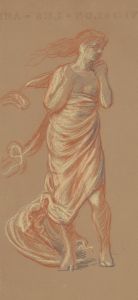
La Japonaise Au Bain
A hand-painted replica of James Tissot’s masterpiece La Japonaise Au Bain, meticulously crafted by professional artists to capture the true essence of the original. Each piece is created with museum-quality canvas and rare mineral pigments, carefully painted by experienced artists with delicate brushstrokes and rich, layered colors to perfectly recreate the texture of the original artwork. Unlike machine-printed reproductions, this hand-painted version brings the painting to life, infused with the artist’s emotions and skill in every stroke. Whether for personal collection or home decoration, it instantly elevates the artistic atmosphere of any space.
James Tissot, a French painter known for his detailed and fashionable depictions of contemporary life, created "La Japonaise au Bain" in the late 19th century. Tissot, whose full name was Jacques Joseph Tissot, was born on October 15, 1836, in Nantes, France. He was a prominent figure in the art world during his lifetime, particularly noted for his works that captured the essence of the Victorian era.
"La Japonaise au Bain" is one of Tissot's works that reflects the Western fascination with Japanese culture during the period known as Japonisme. This cultural phenomenon swept through Europe in the latter half of the 19th century, influencing various forms of art, including painting, ceramics, and fashion. Artists like Tissot were captivated by the aesthetics of Japanese art, which offered a fresh perspective compared to traditional Western styles.
The painting depicts a woman in a bath, adorned in a kimono, which is a traditional Japanese garment. This choice of attire highlights the influence of Japanese culture on Tissot's work. The kimono, with its intricate patterns and vibrant colors, is a focal point of the painting, showcasing Tissot's attention to detail and his ability to capture the textures and nuances of fabric. The setting of the painting is intimate, providing a glimpse into a private moment, which was a common theme in Tissot's work.
Tissot's technique in "La Japonaise au Bain" is characterized by his use of light and shadow, creating a sense of depth and realism. His brushwork is meticulous, and he employs a palette that emphasizes the contrast between the subject and her surroundings. This approach not only highlights the central figure but also draws attention to the cultural elements present in the painting.
The painting is part of Tissot's broader exploration of themes related to fashion, femininity, and cultural exchange. During the time Tissot was active, there was a growing interest in the exotic and the foreign, driven by increased global travel and trade. This interest is evident in "La Japonaise au Bain," as it reflects the blending of Eastern and Western artistic traditions.
Tissot's work, including "La Japonaise au Bain," is often celebrated for its narrative quality. His paintings frequently tell a story or capture a moment in time, inviting viewers to engage with the scene on a deeper level. This narrative aspect, combined with his technical skill, has ensured Tissot's place in art history as a significant figure of the 19th century.
"La Japonaise au Bain" remains an important piece within Tissot's oeuvre, illustrating his ability to merge different cultural influences into his work. It stands as a testament to the impact of Japonisme on Western art and the enduring appeal of Tissot's paintings, which continue to be studied and admired for their beauty and historical significance.











![The Commader in Chief in India [General Sir Frederick Paul Haines], Military and Navy, from Vanity Fair, March 25, 1876](/imgs/214448/s/james-tissot-the-commader-in-chief-in-india-general-sir-frederick-paul-haines-military-and-navy-from-vanity-fair-march-25-1876-18a8ea9e.jpg)






